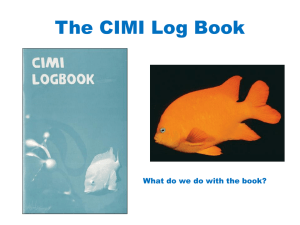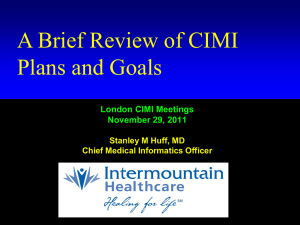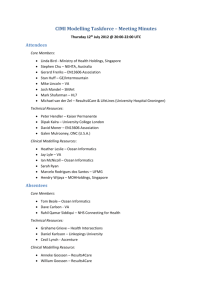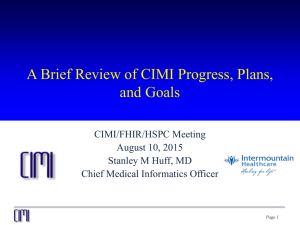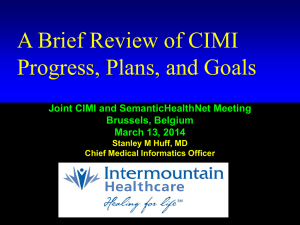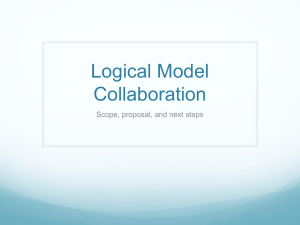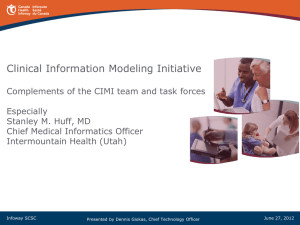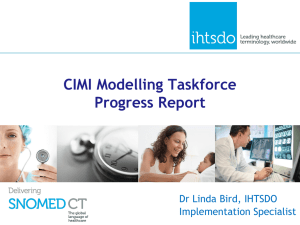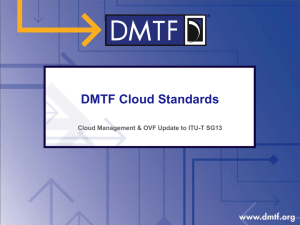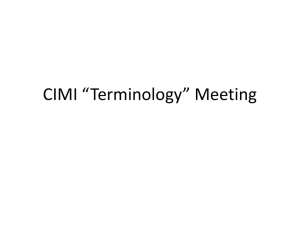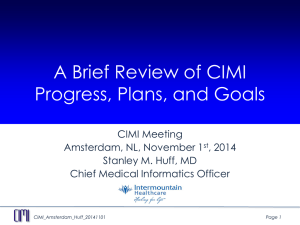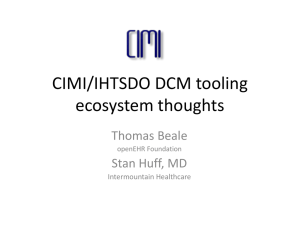Slides - Mayo Clinic Informatics
advertisement
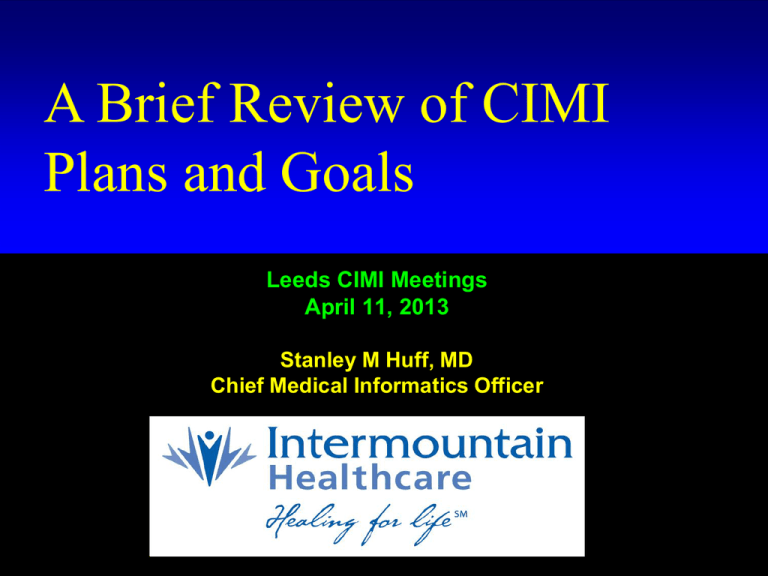
A Brief Review of CIMI Plans and Goals Leeds CIMI Standards Meetings Kaiser Permanente Summit April 11, 7-8 2013 September , 2011 Stanley M. Huff, MD Stanley M Huff, MD Chief Medical Informatics Officer Huff # 1 If you don’t understand or if you disagree with something I say, please speak up! The Ultimate Value Proposition of CIMI • Interoperable sharing of: – Data – Information – Applications – Decision logic – Reports – Knowledge Huff # 3 Clinical System Approach Intermountain can only provide the highest quality, lowest cost health care with the use of advanced clinical decision support systems integrated into frontline clinical workflow Decision Support Modules • • • • Antibiotic Assistant Ventilator weaning ARDS protocols Nosocomial infection monitoring • MRSA monitoring and control • Prevention of Deep Venous Thrombosis • Infectious disease reporting to public health • • • • • • • • • • Diabetic care Pre-op antibiotics ICU glucose protocols Ventilator disconnect Infusion pump errors Lab alerts Blood ordering Order sets Patient worksheets Post MI discharge meds Strategic Goal • Be able to share data, applications, reports, alerts, protocols, and decision support modules with anyone in the WORLD Order Entry API (adapted from Harold Solbrig) ... Application Interface Service Data COS From Ben Adida and Josh Mandel What Is Needed to Create a New Paradigm? • Standard set of detailed clinical data models coupled with… • Standard coded terminology • Standard API’s (Application Programmer Interfaces) for healthcare related services • Open sharing of models, coded terms, and API’s • Sharing of decision logic and applications Clinical modeling activities • • • • • • • • • • • • Netherlands/ISO Standard CEN 13606 United Kingdom – NHS Singapore Sweden Australia openEHR Foundation Canada US Veterans Administration US Department of Defense Intermountain Healthcare Mayo Clinic • HL7 – Version 3 RIM, message templates – TermInfo – CDA plus Templates – Detailed Clinical Models – greenCDA • Tolven • NIH/NCI – Common Data Elements, CaBIG • CDISC SHARE • Korea • Brazil # 10 Clinical Information Modeling Initiative Mission Improve the interoperability of healthcare systems through shared implementable clinical information models. Huff # 11 Clinical Information Modeling Initiative Goals • Shared repository of detailed clinical information models • Using a single formalism • Based on a common set of base data types • With formal bindings of the models to standard coded terminologies • Repository is open and models are free for use at no cost Huff # 12 Goal: Models that support multiple contexts • • • • • • • • Message payload and service payload Decision logic (queries of EHR data) EHR data storage Clinical trials data (clinical research) Quality measures Normalization of data for secondary use Creation of data entry screens Natural Language Processing output Information Model Ideas CEMs DCMs CDA Templates Repository of Shared Models in a Single Formalism V2 “|” CEM Standard LRA Terminologies V2 XML HTML V3 XML V3 Next Realm Realm Specific UML Realm Translators Specific Specializations Realm Specific Specializations Realm Specific Specializations Specific Specializations Specializations openEHR Archetypes CEN Archetypes LRA Models FHIR Resources Initial Loading of Repository Translators Translators ADL CDA OWL SOA CDISC SHARE CEN Payload Archetype # 14 Roadmap (some parallel activities) • Choose a single formalism • Define the core reference model, including data types (leaf types) • Define our modeling style and approach – Development of “style” will continue as we begin creating content Roadmap (continued) • Create an open shared repository of models – Requirements – Find a place to host the repository – Select or develop the model repository software • Create model content in the repository – Start with existing content that participants can contribute – Must engage clinical experts for validation of the models Roadmap (continued) • Create a process (editorial board?) for curation and management of model content • Resolve and specify IP policies for open sharing of models • Find a way of funding and supporting the repository and modeling activities • Create tools/compilers/transformers to other formalisms – Must support at least ADL, UML/OCL, Semantic Web, HL7 • Create tools/compilers/transformers to create what software developers need (joint work) – Examples: XML schema, Java classes, CDA templates, greenCDA, RFH, SMART RDF, etc. Relation of CIMI to other Initiatives • • • • • • • HL7 RIM CDA and CCDA FHIR Virtual Medical Record Quality models SMART SHARP Selected Policies, Decisions, and Milestones Decisions (London, Dec 1, 2011) • We agreed to: – Create models using a CIMI core reference model – ADL 1.5 as the initial formalism, including Archetype Object Model – A CIMI UML profile (Archetype Modeling Language, AML) will be developed concurrently as a set of UML stereotypes, XMI specifications and transformations Definition of “Logical Model” • Models show the structural relationship of the model elements (containment) • Coded elements have explicit binding to allowed coded values • Models are independent of a specific programming language or type of database • Support explicit, unambiguous query statements against data instances Further modeling decisions • Models shall specify a single preferred unit of measure (unit normalization) • Models can support inclusion of processing knowledge • One or more examples of instance data will be created for each model – The examples can show both proper and improper use Isosemantic Models Precoordinated Model (CIMI deprecated Model) HematocritManual (LOINC 4545-0) HematocritManualModel data 37 % Post coordinated Model (CIMI preferred Model) Hematocrit (LOINC 20570-8) HematocritModel data 37 % quals HematocritMethodModel data Hematocrit Method Manual # 23 Isosemantic Models • CIMI supports isosemantic clinical models: – We will keep isosemantic models in the CIMI repository that use a different split between pre-coordination versus post coordination (different split between terminology and information model) – One model in an isosemantic family will be selected as the preferred model for interoperability (as opposed to everyone supporting every model) – Profiles of models for specific use cases will be created by authoritative bodies: professional societies, regulatory agencies, public health, quality measures, etc.) Terminology • SNOMED CT is the primary reference terminology • LOINC is also approved as a reference terminology – In the event of overlap, SNOMED CT will be the preferred source • CIMI will propose extensions to the reference terminologies when needed concepts do not exist • CIMI has obtained a SNOMED extension identifier • CIMI and IHTSDO have approved a “public good” use agreement for use of SNOMED CT in CIMI models Terminology (cont) • The primary version of models will only contain references (pointers) to value sets • We will create tools that read the terminology tables and create versions of the models that contain enumerated value sets (as in the current ADL 1.5 specification) March 29, 2012 – Semantic Interoperability • IEC affirms that CIMI models must be capable of supporting semantic interoperability across a federation of enterprises. CIMI models are not limited to supporting semantic interoperability only within an enterprise or to just syntactic or structural interoperability • We will define not only the semantic meaning of each node in the clinical model, but to also define the semantic meaning of the relationship between each parent and child node in the hierarchy. • SNOMED relationship concepts will be used to define the parent-child relationships in the models. Pleasanton May 10-12, 2012 • The initial version of the CIMI Reference Model (including data types) was approved Content Ownership and Intellectual Property • Those who contribute models to CIMI will retain ownership and the IP of the models, but they grant CIMI a license to use the model content at no cost in perpetuity and to allow CIMI to sublicense the use of the models at no cost to those who use the models Some Principles • CIMI DOES care about implementation. There must be at least one way to implement the models in a popular technology stack that is in use today. The models should be as easy to implement as possible. • Only use will determine if we are producing anything of value – Approve “Good Enough” RM and DTs – Get practical use ASAP – Change RM and DTs based on use Have I left out any important decisions, policies, or milestones? Huff # 31 Primary Near Term Goals • As soon as possible, make some high quality CIMI models available in a web accessible repository – ADL 1.5 (AOM framework) and/or UML ( XMI) – That use the CIMI reference model – That have complete terminology bindings • Get the models used in someone’s working system • Document our experience Goals for Leeds Meeting • Make decisions about tooling – Model editor(s) – Terminology editor(s) • • • • Determine registry/repository approach Continue modeling work How to approach CIMI as a business entity CIMI enterprise architecture, communication, and public information • (We need to record and highlight in our minutes any decisions we make) Conflicts of Interest Huff # 34
